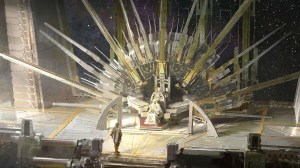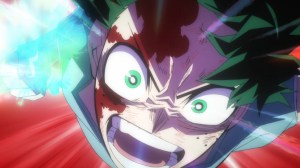A vehicle designer knows they’ve come up with a great design when their vehicle becomes a character in itself. For Los Angeles-based conceptual artist Nick Pugh, who has worked on numerous feature films over the past two decades, he struck gold with his limousine desing for 20th Century Fox’s Logan.
Videos by ComicBook.com
The vehicle plays a vital role in film from its first appearance to its last. It’s used in the opening scene, when Wolverine slices and dices a gang of thieves, to establish the film’s gritty, grounded, and ultra-violent tone, as well as establishing how far Wolverine will go to protect his only source of income — which could give him the means to purchase a boat for him and Charles Xavier to live in isolation.
It then plays a major role when the Reavers show up at his Mexican hideout looking for X-23. When they find her and get their butts handed to them by her, she eventually ends up in it and a chase scene ensues. The limo quickly becomes a bullet-ridden vehicle as it goes through ditches, drags fences, gets smacked by a moving train, and tears across the desert.
Pugh was kind enough to take part in an interview with us, discussing the designs he came up with for the limo as well as the Reavers’ vehicles and the self-driving trucks. He also provided us with concept art for them, which you can view by clicking on START SLIDESHOW.
I like that Logan‘s limo looked like it was from the future but not too futuristic. Was that your goal?
Nick Pugh: The director wanted Logan to drive a vehicle that was not new in 2029, so this limo is probably 5 years old by then. We tried not to make a design that drew too much attention to itself but also was something that you have not seen before. It is supposed to be an evolutionary step or two ahead but not gee wiz hi-tech futuristic. The style of the film dictated a car that was strong and masculine, but not pretty or flashy.
Did you know that the limo would be part of an action sequence, and did that influence your design?
Nick Pugh: Yes, it was clear from the script that the limo was going to get totally destroyed and needed to survive all sorts of damage. This did not greatly influence the design but it greatly affected the way the car was built. Much of the movie was not filmed in order due to actors schedules and location availability, so the entire car can be shown in a destroyed state and be put back together again as new. There were 4 stages of damage that we needed to be able to flip between at any given time. The actual crash scenes don’t produce damage, the damaged panels are swapped in between takes and CGI or practical effects cover the transitions.
What was the most challenging part of the working on Logan?
Nick Pugh: For me there were two primary challenges in designing vehicles for Logan. 1) It is imperative and often very difficult to create a design that perfectly fits into the plot. In designing real products one often adheres to the idea that form follows function but in designing for movies form follows story. If your design distracts from the story, it is weak, but if it enhances the story or makes the cinematic world more believable, then it is a success. 2) It is always a challenge to build something decent in such a short time with the limited budgets given and Logan was no exception. It is why movie cars often have poor fit and finish and don’t really work very well; as a designer, this is always hard to deal with.
Were there any futuristic features for these vehicles that didn’t make it into the film?
Nick Pugh: Yes! There were many. In fact the original script called for the movie to be set around 2040 so we started out much further ahead but the director wanted the whole thing to be as realistic as possible so the timeline was reeled in to 2029. We had many features and ideas that were not used. Here are two: 1) Smart Mirror Technology (SMT). This idea arose from the thought that both autonomous vehicles and human driven vehicles will be sharing the road in the near to mid term future and the need for them to communicate effectively will be critical. So sometime in the next 10 years or so NHTSA will mandate that all vehicles, new, used or robot driven will be required to carry SMT onboard communication and collision avoidance system. We decided that the side mirror might be a logical place for such a technology to be placed since it is both very visible, easily added to old cars and visually communicates an overall future feeling for all the cars in Logan despite their age. 2) Hi-Lumen Active Matrix Lighting. This idea combines futuristic display screen technology with the headlights and tail lights of cars. Imagine an iPad screen as bright as a headlight that could be animated, send visual signals between vehicle passengers or change style or design depending on the vehicles usage or personal style of its owner.
How did you approach designs for the self-driving trucks?
Nick Pugh: The self driving trucks were intended to be brutal, soulless and functional. They also are the only time where autonomous vehicle ideas are shown and we all felt strongly that their design should be very different than existing truck styling, hence the total removal of the cab. The other influence that effected them was looking at the whole macro view of the ISO container shipping system and trying to imagine what the future of this industry might evolve into, the illustrated diagram above shows this idea.
Of all the vehicle designs, which was the most challenging?
Nick Pugh: The limo for sure. It had to represent so many things and do so many things. Its Logan’s own personal car, so the screen time and space it occupied was significant. It is supposed to be based on a production car from the future, so giving it some real car company DNA was critical. It needs to perform all kinds of stunts, so there was a 500 HP Baja style tube frame vehicle with 18″ of suspension travel produced as well! And getting the fit and finish into the body work in such a short time/budget was hard and only somewhat successful.
In 2029, the mutant population has shrunk significantly and the X-Men have disbanded. Logan, whose power to self-heal is dwindling, has surrendered himself to alcohol and now earns a living as a chauffeur. He takes care of the ailing old Professor X whom he keeps hidden away. One day, a female stranger asks Logan to drive a girl named Laura to the Canadian border. At first he refuses, but the Professor has been waiting for a long time for her to appear. Laura possesses an extraordinary fighting prowess and is in many ways like Wolverine. She is pursued by sinister figures working for a powerful corporation; this is because her DNA contains the secret that connects her to Logan. A relentless pursuit begins … In this third cinematic outing featuring the Marvel comic book character Wolverine we see the superheroes beset by everyday problems. They are ageing, ailing and struggling to survive financially. A decrepit Logan is forced to ask himself if he can or even wants to put his remaining powers to good use. It would appear that in the near-future, the times in which they were able put the world to rights with razor sharp claws and telepathic powers are now over.
Logan stars Hugh Jackman (Logan), Boyd Holbrook (Donald Pierce), Patrick Stewart (Charles Xavier), Dafne Keen (Laura Kinney/X-23), Stephen Merchant (Caliban), Elizabeth Rodriguez (Gabriela), and Richard E. Grant (Dr. Zander Rice).
James Mangold (The Wolverine) directed, based on a screenplay he co-wrote with screenwriters Scott Frank and Michael Green.
Logan is now playing!
MORE: Logan Crosses $200 Million At North American Box Office / Logan Director Explains His Disdain For Superhero Films / Logan: Unused Reavers Concept Art / Logan Passes $500 Million Global Box-Office Benchmark


























